air suspension AUDI S8 2012 Owners Manual
[x] Cancel search | Manufacturer: AUDI, Model Year: 2012, Model line: S8, Model: AUDI S8 2012Pages: 300, PDF Size: 75.06 MB
Page 14 of 300
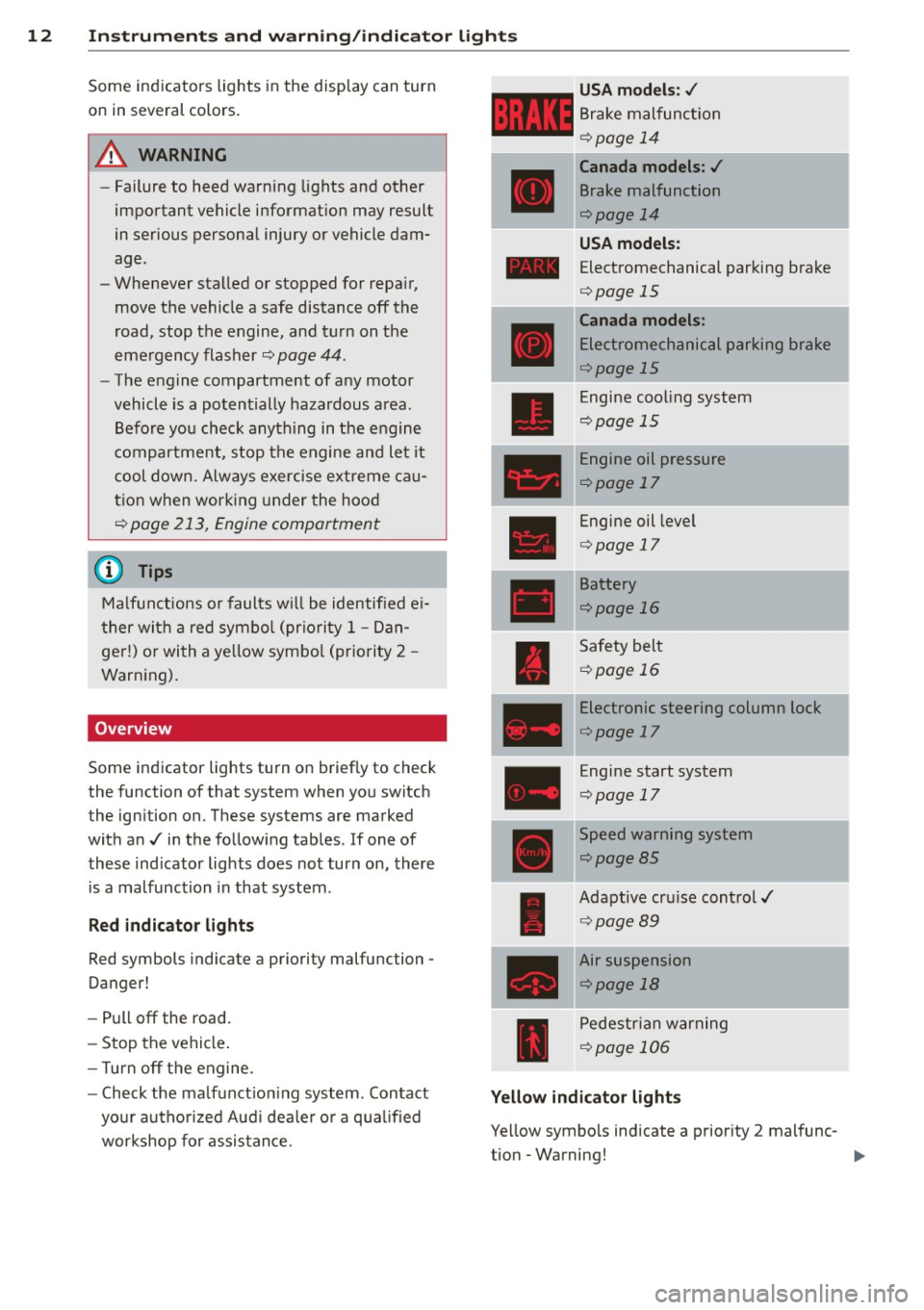
12 Instrum ent s and w arn ing /indic ato r light s
Some indicators lights in the disp lay can turn
on in several colors.
A WARNING
-Failure to heed warning lights and other
important vehicle information may result
in serious personal injury or vehicle dam
age.
- Whenever stalled or stopped for repair,
move the vehicle a safe distance off the
road, stop the engine, and turn on the
emergency flasher
¢ page 44.
- The engine compartment of any motor
vehicle is a potentially hazardous area.
Before you check anything in the engine
compartment, stop the engine and let it
cool down. Always exercise extreme cau
t ion when work ing under the hood
¢ page 213, Engine compartment
(D Tips
Ma lfun ctions or faults w ill be identified e i
ther with a red symbo l (pr iority 1 -Dan
ger!) or with a ye llow symbo l (pr iority 2 -
Warning).
Overview
Some indicator lights turn on briefly to check
the function of that system when you switch
the ign ition on. These systems are marked
with an./ in the follow ing tables . If one of
these indicator lights does not turn on, there
is a malfunction in that system .
Red indic ator light s
Red symbols indicate a priority malfunction -
Danger!
- Pull off the road.
- Stop the vehicle .
- T urn off the engine.
- Check the malfunct ion ing system. Contact
your authorized Aud i dea ler o r a qua lified
workshop for assis tance.
USA m odel s: ./
Brake malfunction
¢page 14
Canada models : ./
Brake malfunction
¢page 14
USA model s:
-
Electromechanical parking brake
¢page 15
Canada models :
Electromechanical parking brake
¢page 15
Engine cooling system
¢page 15
Engine oil pressure
¢page 17
Engine oil level
¢page 17
Battery
¢page 16
Safety belt
¢page 16
Electronic steering column lock
¢page 17
Engine start system
¢page 17
Speed warning system
¢page85
I
Adaptive cru ise control./
¢ page89
Air suspension
¢page 18
Pedestrian warning
¢page 106
Yellow ind icator light s
Yellow symbo ls indicate a priority 2 malfunc-
tion - Warning!
...
Page 16 of 300
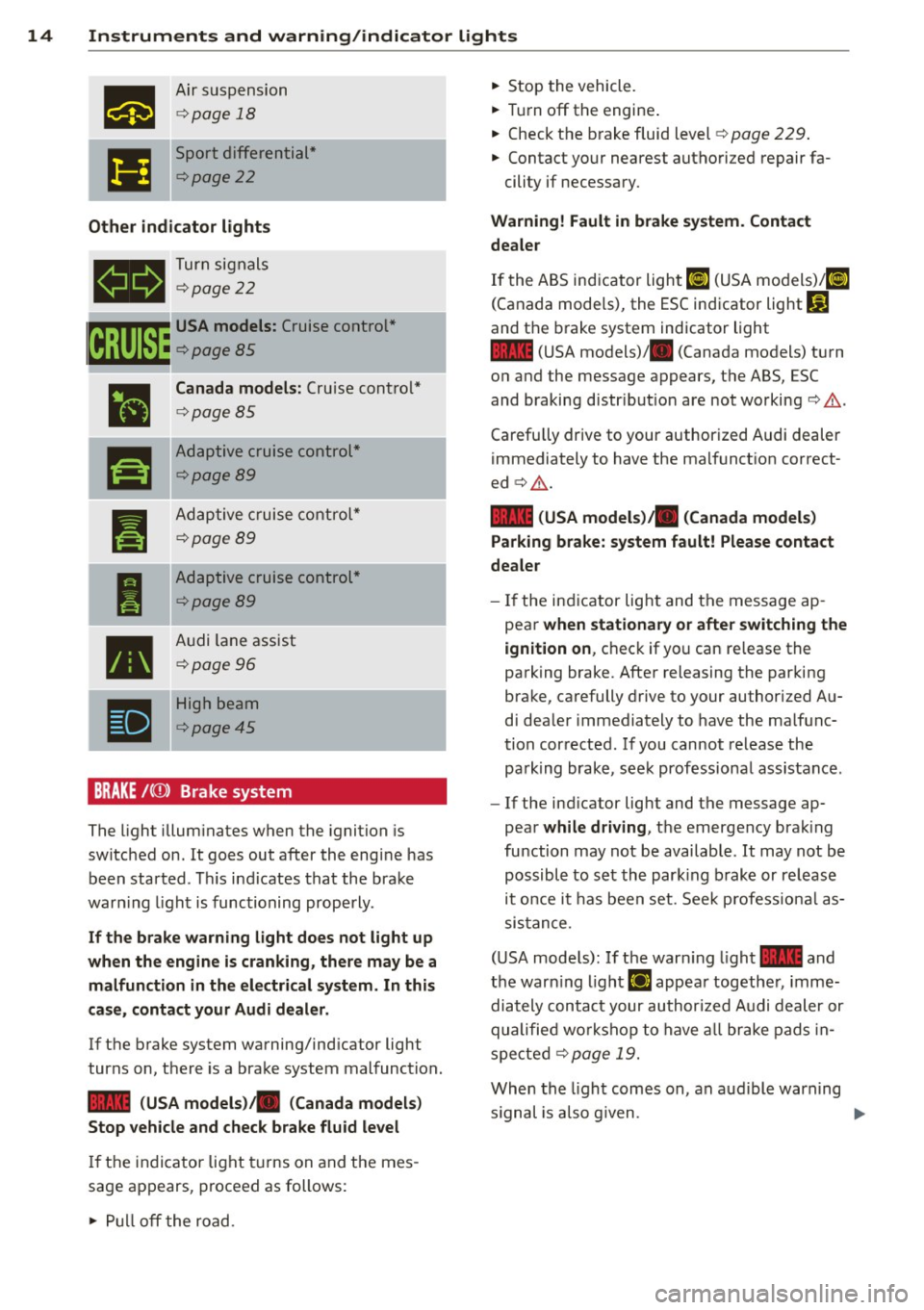
14 Instruments and warning/indicator lights
Air suspension
¢page 18
Sport differential*
¢page22
Other indicator lights
- Turn
signals
¢page22
~ USA models: Cruise control *
~ ¢ page 85
•
Canada models: Cruise control*
¢page 85
-
r!I
Adaptive cruise control*
¢page89
•
Adaptive cruise control*
¢page 89
-
I
Adaptive cruise control*
¢page89
•
Audi lane assist
¢ page 96
-
•
High beam
¢page45
BRAKE /((f)) Brake system
The light illuminates when the ignition is
switched on . It goes out after the engine has
been started . This indicates that the brake
warn ing light is functioning properly.
If the brake warning light does not light up
when the engine is cranking, there may be a
malfunction in the electrical system. In this
case, contact your Audi dealer.
If the brake system warning/ind icator light
turns on, there is a brake system malfunction.
- (USA models)/ . (Canada models)
Stop vehicle and check brake fluid level
If the indicator light turns on and the mes
sage appears, proceed as follows:
"" Pull off the road . ""
Stop the vehicle.
"" Turn off the engine .
"" Check the brake fluid level ¢
page 229.
"" Contact your nearest authori zed repair fa-
cility if necessary.
Warning! Fault in brake system. Contact
dealer
If the ABS indicator light ti] (USA models)/ rl]
(Canada models), the ESC indicator light G]
and the brake system indicator light
- (USA models)/ . (Canada models) turn
on and the message appears, the ABS, ESC
and braking distr ibut ion are not working¢.&..
Carefu lly drive to your authorized Audi dealer
immediately to have the malfunction correct
ed ¢.&. .
- (USA models) . (Canada models)
Parking brake: system fault! Please contact
dealer
- If the indicator light and the message ap
pear
when stationary or after switching the
ignition on , check if you can release the
parking brake. After releasing the parking
brake, carefully drive to your authorized Au
di dealer immediately to have the malfunc
tion corrected. If you cannot release the
pa rking brake, seek professiona l assistance.
- If the ind icator light and the message ap
pear
while driving, the emergency brak ing
function may not be available . It may not be
possible to set the park ing brake or release
it once it has been set. Seek profess ional as
sistance.
(USA models): If the warn ing light - and
the warn ing l ight
El appear together, imme
diately contact your authorized Audi dealer or
qualified wo rkshop to have all brake pads in
spected
¢ page 19.
When the light comes on, an audible warning
s ignal is also given .
Ill-
Page 20 of 300
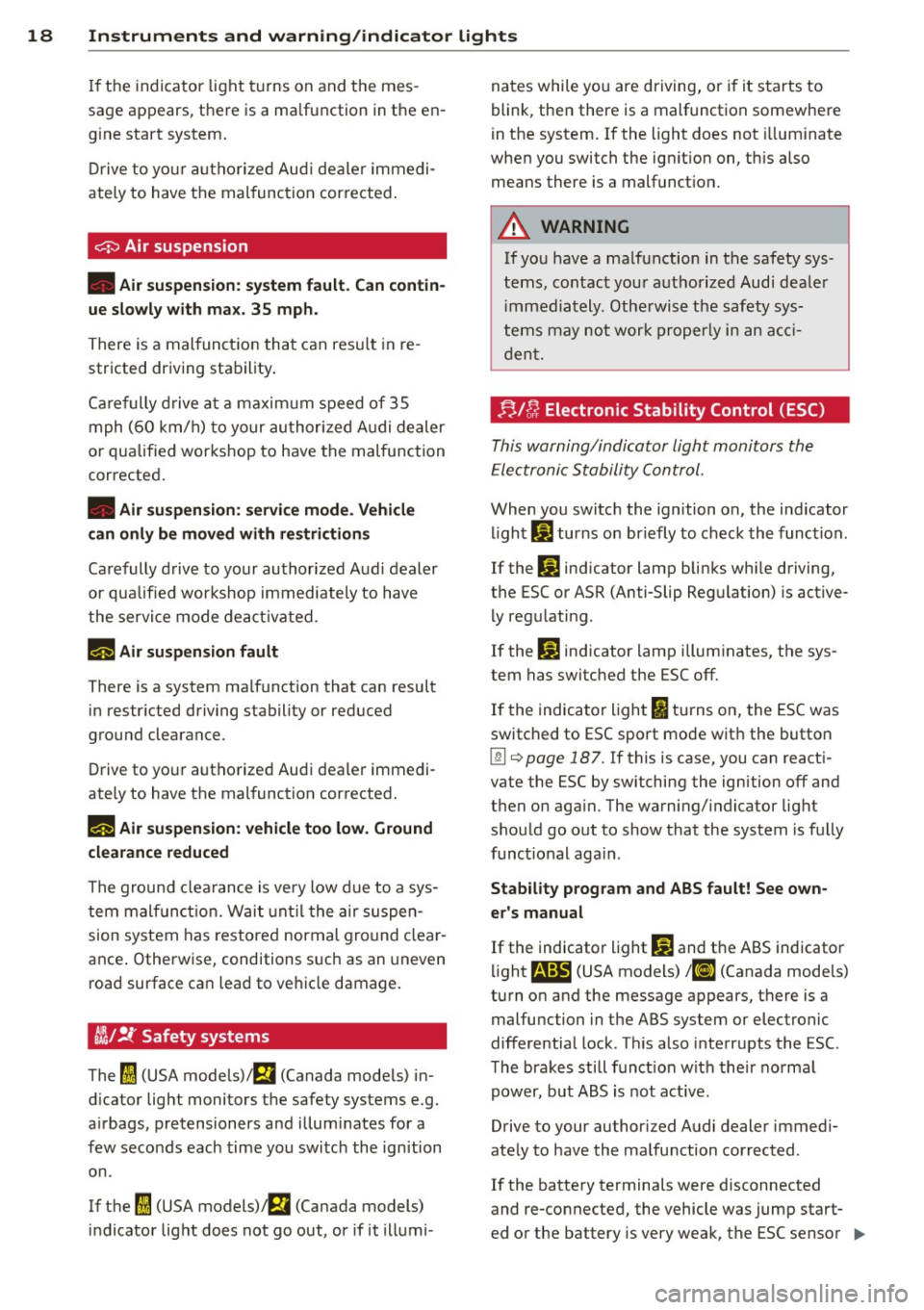
18 Instruments and warning/indicator lights
If the indicator light turns on and the mes
sage appears, there is a ma lfunction in the en
g ine start system.
Drive to your authorized Aud i dealer immedi
ate ly to have the malfunction cor rected .
0 Air suspension
• Air suspension: system fault. Can contin
ue slowly with max. 35 mph .
There is a malfunction that can result in re
stricted driving stability .
Ca refully drive at a maximum speed of 35
mph
(60 km/h) to your authorized Audi dealer
or qualified workshop to have the malfunction
corrected .
• Air suspension: service mode. Vehicle
can only be moved with restrictions
Carefully drive to your authorized Audi dealer
or qualified workshop immediately to have
the service mode deactivated.
Ill Air suspension fault
There is a system ma lfunction that can result
in restr icted driving stability or reduced
ground clearance.
Drive to your authorized Audi dea ler immedi
ate ly to have the malfunction corrected.
IIJ Air suspension: vehicle too low. Ground
clearance reduced
The ground clea rance is ve ry low due to a sys
tem malfunct ion. Wait until the air suspen
sion system has restored normal ground clear
ance . Otherwise, conditions such as an uneven
road surface can lead to ve hicle damage.
~/ !f Safety systems
The fl (USA models) ;BI (Canada models) in
d icator light monitors the safety systems e.g.
a ir bags, pretensioners and illum inates for a
few seconds each time you switch the ignition
on .
If the
I (USA models) ;BI (Canada models)
indicator light does not go out, or if it illumi- nates while you are driving, or if it starts to
blink,
then there is a malfunction somewhere
in the system.
If the light does not illuminate
when you switch the ign it ion on, th is also
means there is a malfunct ion.
A WARNING '"--
If you have a ma lfunction in the safety sys-
tems, contact your authorized Audi dea ler
imme diately. Otherwise the safety sys
tems may not work properly in an acci
dent.
fJJ [}, Electronic Stability Control (ESC)
This warning/indicator light monitors the
Electronic Stability Control.
When you switch the ignition on, the indicator
light
G1 turns on briefly to check the function.
If the
J.iJ ind icator lamp blinks wh ile driving,
the ESC or ASR (Anti-Slip Regulation) is active
ly regulating.
If
the DJ ind icator lamp illuminates, the sys·
tern has switched the ESC off.
If the indicator light fi turns on, the ESC was
switched to ESC sport mode with the button
[!] c::, page 187. If this is case, you can reacti
vate the ESC by switching the ignition off and
then on aga in. The warning/indicator light
should go out to show that the system is fully
functional again .
Stability program and ABS fault! See own
er 's manual
If the indicator light DJ and the ABS indicator
li ght
m (USA models) ;II] (Canada models)
turn on and the message appears, there is a malfunction in the ABS system or electronic
differential lock. Th is also interrupts the ESC.
The brakes still funct ion wit h their normal
power, but ABS is not active .
Drive to your authorized Audi dealer immedi
ately to have the malfunction corrected .
If the battery terminals were disconnected
and re-connected, the vehicle was jump start-
ed or the battery is very weak, the ESC sensor .,,.
Page 105 of 300
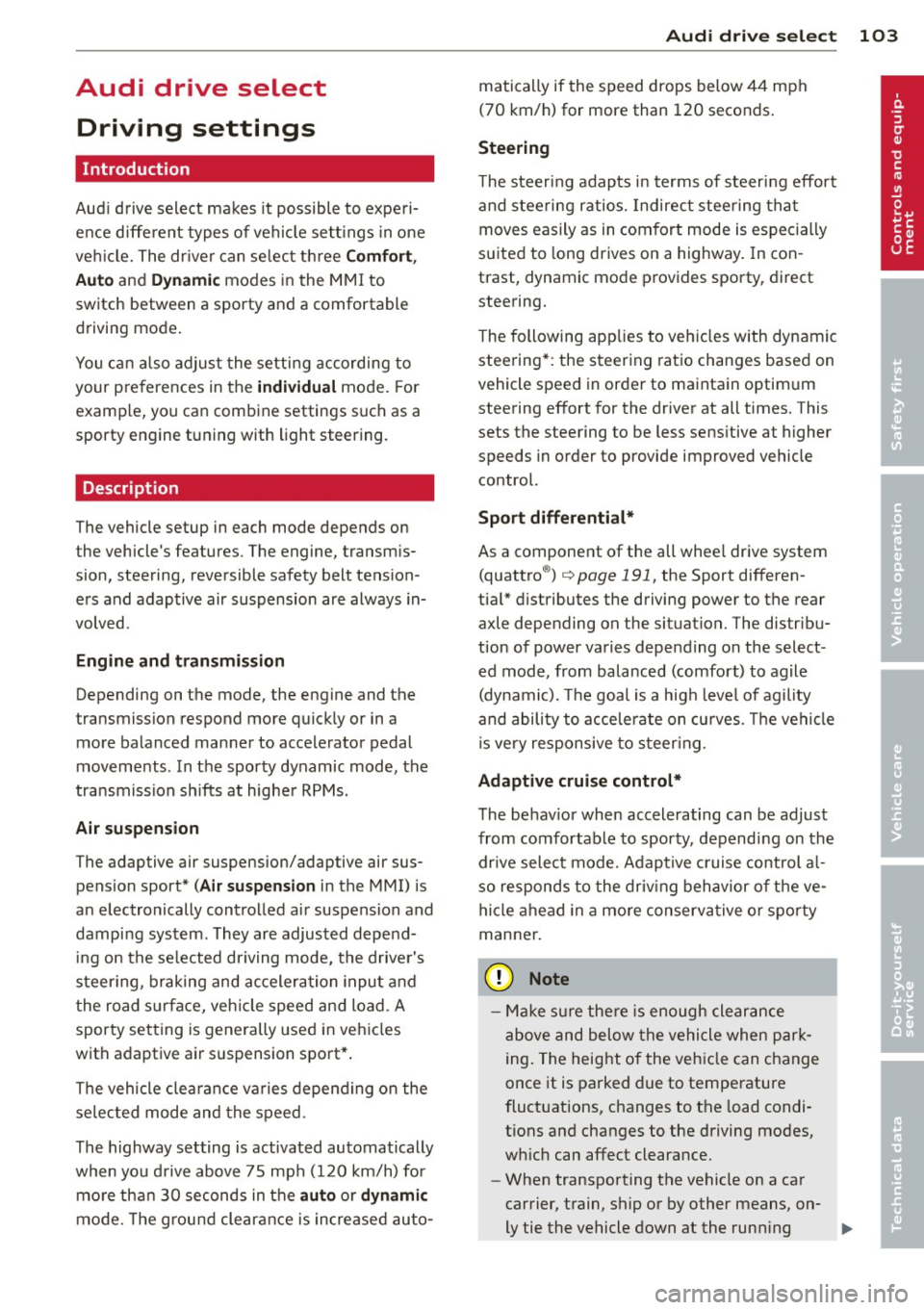
Audi drive select Driving settings
Introduction
Aud i drive select makes it possible to experi
ence different types of vehicle settings in one
veh icle. The driver can select th ree
Comfort,
Auto
and Dynamic modes in the MMI to
switch between a sporty and a comfortable
driving mode.
You can also adjust the setting according to
your preferences in the
individual mode. For
examp le, you can combine settings such as a
sporty engine tuning with light steering.
Descript ion
The vehicle setup in each mode depends on
the vehicle's features. The engine, transmis
sion, steering, reversible safety belt tension
ers and adaptive air suspension are always in
volved .
Engine and transmission
Depending on the mode, the engine and the
transmission respond more quickly or in a
more balanced manner to accelerator pedal
movements. In the sporty dynamic mode, the
transmission sh ifts at higher RPMs.
Air suspension
The adaptive air suspension/adaptive air sus
pension sport*
( Air suspension in the MMI) is
an electronically cont rolled air suspension and
damping system. They are adjusted depend ing on the selected driving mode, the driver's
steering, braking and acceleration input and
the road s urface, veh icle speed and load. A
sporty setting is generally used in vehicles
with adaptive air suspension sport *.
The vehicle clearance va ries depending on the
selected mode and the speed .
The highway setting is activated automatically
when you drive above 75 mph (120 km/h) for
mo re than 30 seconds in the
auto or dynamic
mode. The g round clearance is increased auto-
Audi drive select 103
matically if the speed drops below 44 mph
(70 km/h) for more than 120 seconds.
Steering
The steering adapts in terms of steering effort
and steering ratios. Indirect steering that
moves easily as in comfort mode is especially
s ui ted to long drives on a highway. In con
trast, dynamic mode provides sporty, direct
steering.
T he following applies to vehicles with dynamic
steering*: the steering ratio changes based on
vehicle speed in order to maintain optimum
steering effort for the driver at all times. This
sets the steering to be less sens itive at higher
speeds in order to provide improved vehicle
control.
Sport diffe rential*
As a component of the all whee l drive system
(quattro
® ) c> page 191, the Sport differen
tial* distributes the driving power to the rear
axle depending on the situat ion. The dis tribu
tion of power varies depending on the select
ed mode, from balanced (comfort) to agile
(dynamic). The goal is a hig h level of agility
and ability to accelerate on curves. Th e vehi cle
is very responsive to steer ing.
Adaptive cruise control*
The behav ior when accelerating can be adjust
from comfortable to sporty, depending on the
drive select mode. Adaptive cruise control al
so responds to the driving behavior of the ve
hicle ahead in a more conserva tive or sporty
manner.
(D Note
- Make sure there is enough clearance
above and below the vehicle when park
ing . The height of the vehicle can change
once it is parked due to temperature
fluctuations, changes to the load condi
tions and changes to the driving modes,
w hich can affect clearance.
- When transporting the vehicle on a car
carrier, train, ship or by other means, on-
ly tie the vehicle down at the running
IJJ,,
Page 106 of 300
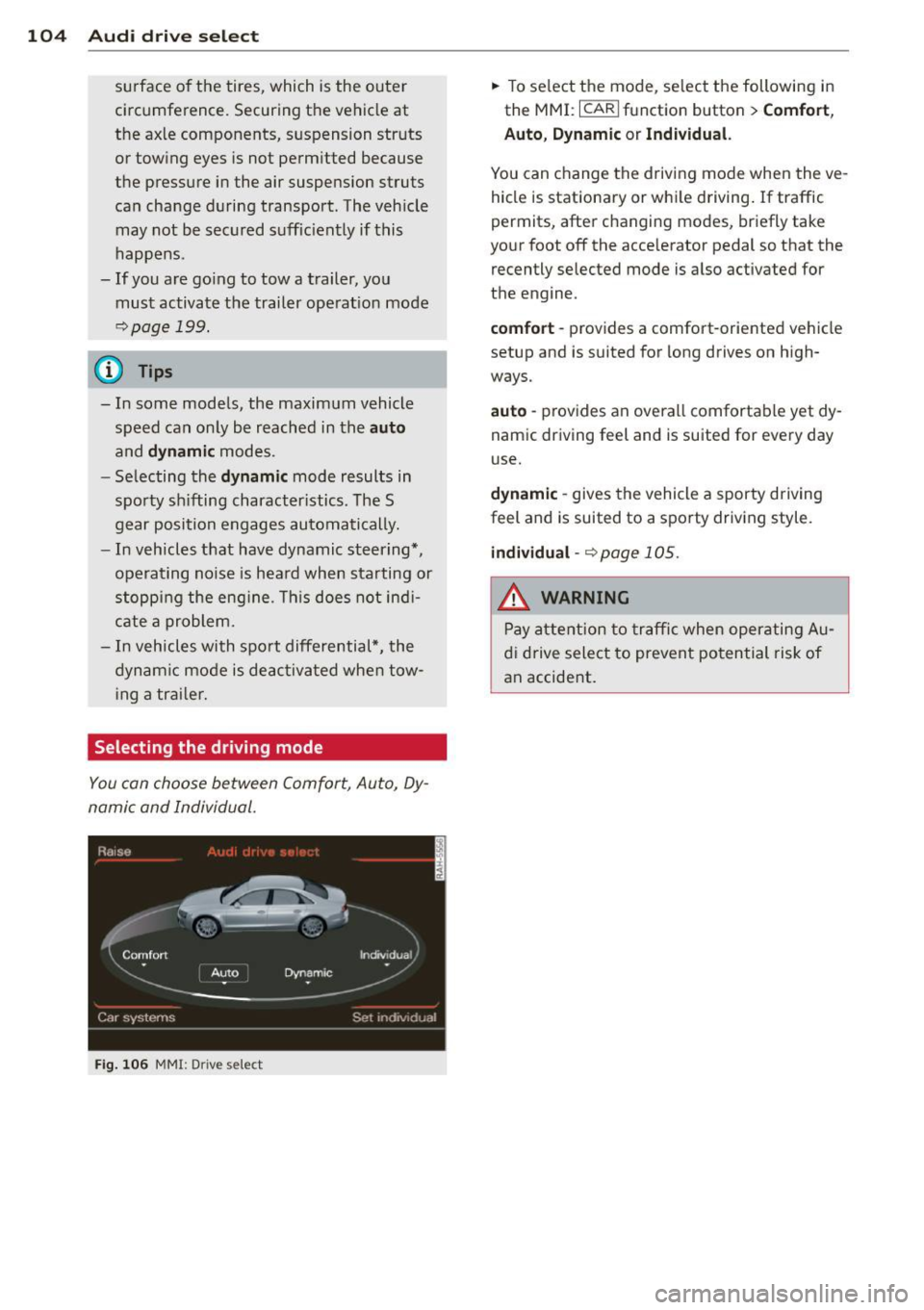
104 Audi dri ve sele ct
surface o f the tires, which is the outer
circumference. Securing the vehicle at
the axle components, s uspension struts
or towing eyes is not perm itted because
the pressure in the air suspension struts
can change during transport. The veh icle
may not be secured suff ic iently if this
happens .
- If you are go ing to tow a trailer, you
must activate the trailer operat ion mode
¢page 199.
@ Tips
- In some models, the maximum vehicle
speed can only be reached in the
auto
and dynamic modes.
- Selecting the
dynamic mode results in
spo rty sh ifting character istics. The S
gear position engages automati cally.
- In vehicles that have dynamic steering*,
operating noise is heard when starting or
stopp ing the eng ine . Th is does not ind i
cate a problem.
- In vehicles with sport differential*, the
dynam ic mode is deactivated whe n tow
i ng a traile r.
Selecting the driving mode
You can choose be tween Comfort, Auto, Dy
namic and Individual.
Fi g. 106 MM!: D rive se lect
.,. To se lect the mode, select the following in
the MMI :
I CARI function button> Comfort ,
Auto , Dynamic or Indi vidu al.
You can change the driving mode when the ve
hicle is stationary or while driving . If traffic
permits, after changing modes, briefly take
your foot off the accelerator pedal so that the
recently selected mode is also activated for
the engine.
comfort -provides a comfort-oriented vehicle
setup and is suited for long drives on high
ways.
auto -provides an overall comfortable yet dy
nam ic driving feel and is suited for every day
use.
d yna mi c -gives the vehicle a sporty driving
feel and is suited to a sporty driving style .
individual -¢ page 105.
A WARNING
Pay attention to traffic when operating Au
d i drive select to prevent potential risk of
an accide .nt.
Page 107 of 300
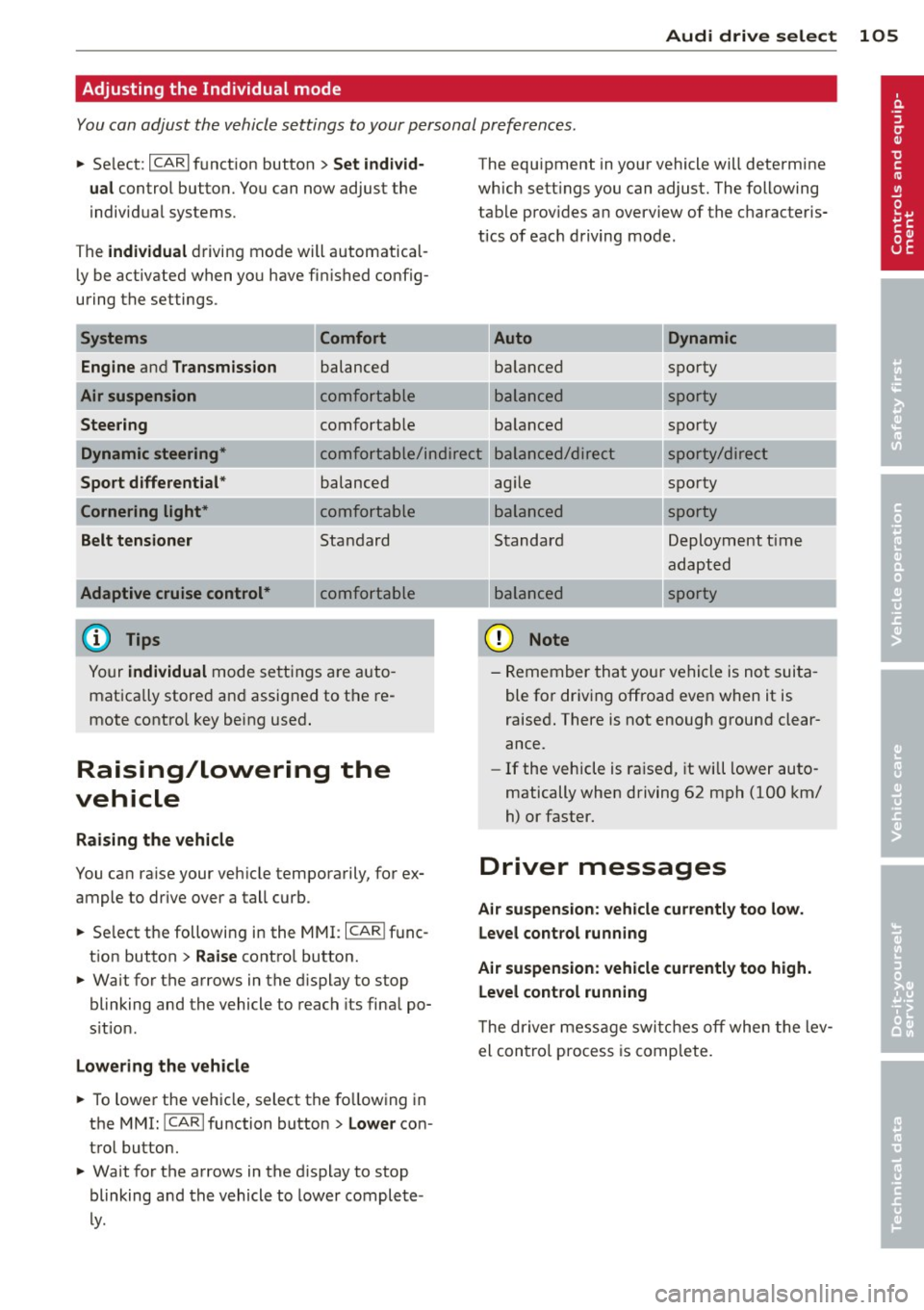
Audi drive select 105
Adjusting the Individual mode
You can adjust the vehicle settings to your personal preferences.
~ Select: ICARlf unct ion button> Set individ·
ual
control button. You can now adjust the
individua l systems.
The
individual d riving mode will automatical
l y be activated when yo u have fin ished config
uring the settings.
Systems
Engine
a nd Transmission
Air suspension Steer ing Comfort balanced
comfo
rtable
comfortab le The equ
ipment in your vehicle will determ ine
which sett ings you can adjust. The following
tab le prov ides a n overview of the c haracteris
tics of eac h driving mode.
Dynamic
ba lanced spo
rty
---.. ,
s porty
ba lanced spo
rty
Dynamic steering*
Sport differential *
Cornering light*
Belt tensioner c o mfo rtable/ind ire c t balanced/dire ct sporty/direc t
spo rty
Adaptive cruise control *
balanced
comfortable
Standard
comfo rtable
Yo ur
individual mode se ttings a re auto
mat ica lly store d an d assig ned to t he re
mote control key bein g use d.
Raising/lowering the
vehicle
Raising the vehicle
You ca n ra ise your veh icle temporarily, for ex
ample to drive over a tall curb.
~ Se lect the following i n the MMI: I CARI f unc
t ion button >
Raise control button.
~ Wait for the arrows in the d isplay to stop
blinking and the vehicle to reach its fina l po
s it io n.
Lowe ring the vehicle
~ T o lower the veh icle, select the fo llow ing in
the MMI: ICARlfunction button>
Lower con
trol button.
~ Wa it for the arrows in the d isplay to stop
blinking and th e vehicle to lower complete
ly . ag
ile
balanced
Standard
balanced
(D Note
---.. ,
---.. ,
sporty Deployment t ime
adapt ed
sporty
- Remember that your ve hicle is not sui ta
ble fo r dr iv ing offroa d even when it is
raised . There is not enough ground clear
ance.
- If the vehicle is ra ised, it will lower auto
matically when driving 62 mph (100 km/
h) or faster.
Driver messages
Air suspension : vehicle currently too low.
Le vel control running
Air suspension: vehicle currently too high. Level control running
T he dr iver mess age swi tches o ff when the lev
el con tro l process is comp lete.
Page 118 of 300

116 Advanc ed Parking S ystem
Rear vi ew cam era co ve ra ge area
The MM I display shows the area covered by
the rear view camera
c::> fig. 123 @ . Objects
that are not in the area covered @are not
shown on the MMI display.
We recommend that you p ractice park ing with
the rear view camera in a t raffic -free location
or parking lot to become familiar with the sys
tem, the orientation lines, and their function.
When doing th is, there sho uld be good light
and weather conditions.
In the MMI disp lay, objects or vehicles appear
closer or further away if:
- you are driving in reverse gear from a level
surface onto an incline, or a downward
s lope,
- you are d riving in reverse gear toward pro
truding objects,
- the vehicle is carrying too much load in the
rear.
The accuracy of the orientation lines and blue
surfaces dim inishes if:
- the adaptive air suspension/sport* is faulty, the vehicle is lifted or dynamic mode is se
lected
c::> page 103,
- the rear view camera does not provide a reli
able image, for examp le, in poor visibility
cond it ions or if the lens is dirty,
- the image on the screen is not visible due to
sun glare and reflect ion.
Car in g for the rear view came ra lens
The rear view camera is located above the rear
license plate bracket . For the parking system
to operate, the lens
c::> fig . 124 must be kept
clean:
- Dampen the lens with a household alcohol
based glass cleaner, and then wipe the lens
clean with a dry cloth
c::> CD.
- Remove snow with a hand brush and ice
preferably with a de-icing spray
c::> (D .
A WARNING
,-
- Senso rs have blind spots in which objects
cannot be detected . Pay special attention to small children and animals because
the sensors cannot always detect them.
- The parking system cannot replace the
driver's attention. The driver alone is re
sponsible for parking and similar driving maneuvers.
- Always keep your eyes on the vehicle 's
surroundings, us ing the rear view mirror
as well.
- Do not allow yourself to be distracted
from traffic by the rear view camera p ic
tures.
- If the position and the installation angle
of the camera has changed, for example,
after a rear end col lis ion, do not continue
to use the system for safety reasons .
H ave it checked by a qualified dea le rship.
(D Note
- Low obstacles a lready s ignaled by a
warning can disappear from the system's detection range as they are approached
and w ill not cont inue to be signaled. Ob
jects such as ba rr ier chains, trailer draw
bars, thin painted vert ica l poles or fen
ces may not be detected by the system,
posing risk of damage .
- N ever use warm or hot water to remove
snow or ice from the rear view camera
lens - this could ca use the lens to crack!
- When cleaning the lens, never use prod
ucts that are abrasive.
Page 159 of 300
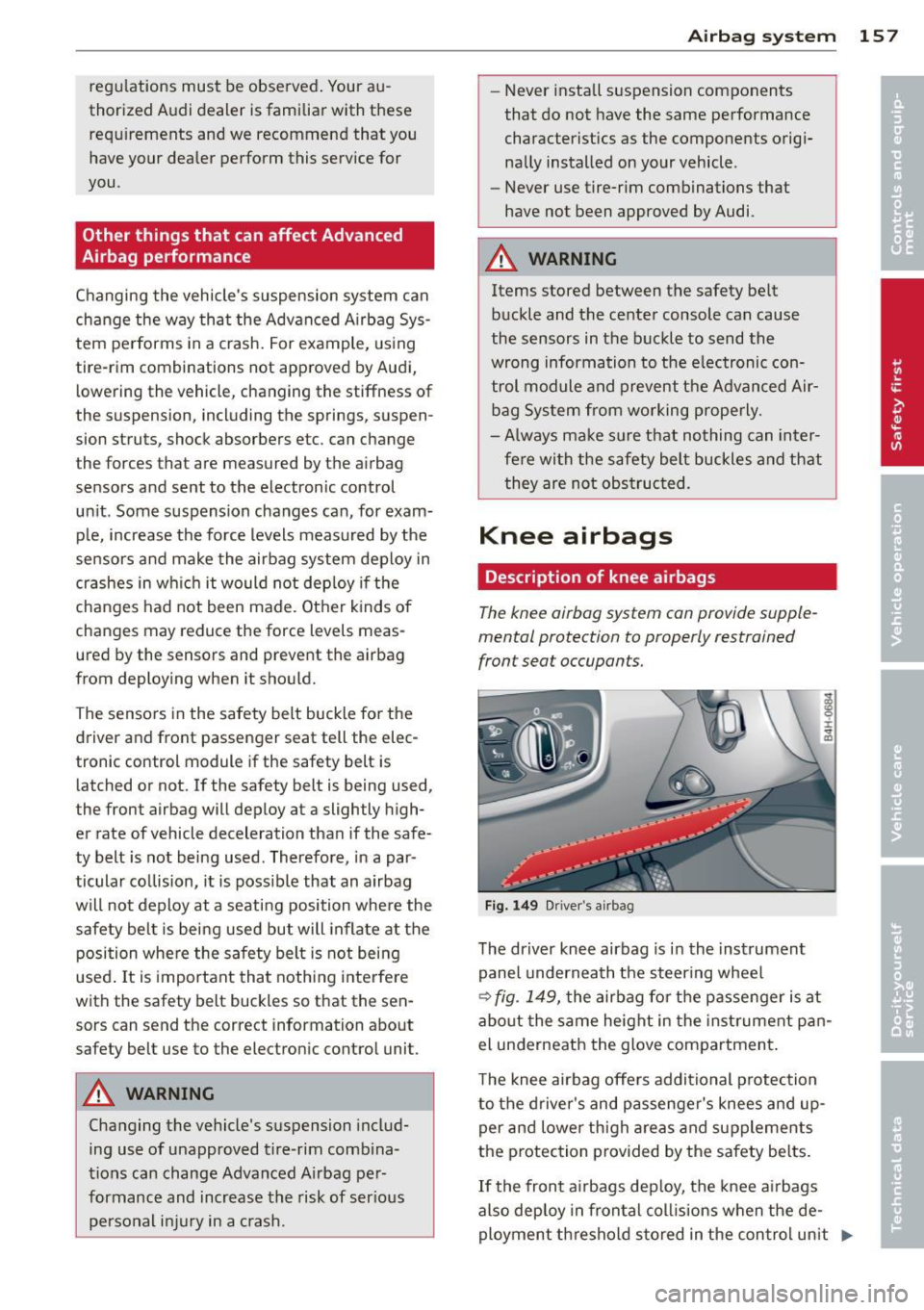
regulations must be observed. Your au
thorized Audi dealer is familiar with these requirements and we recommend that you
have your dealer perform this service for
you.
Other things that can affect Advanced
Airbag performance
Changing the vehicle's suspension system can
change the way that the Advanced Airbag Sys
tem performs in a crash. For example, using
tire-rim combinations not approved by Audi, lower ing the vehicle, changing the stiffness of
the suspension, including the springs, suspen sion struts, shock absorbers etc. can change
the forces that are measured by the airbag
sensors and sent to the electronic control
un it . Some suspension changes can, for exam
ple, increase the force levels measured by the
sensors and make the airbag system deploy in
crashes in which it would not dep loy if the
changes had not been made. Other kinds of
changes may reduce the force Levels meas
ured by the sensors and prevent the airbag
from deploying when it should.
The sensors in the safety belt buckle for the
driver and front passenger seat tell the elec
tronic control module if the safety belt is
latched or not. If the safety belt is being used,
the front airbag will deploy at a slightly high
er rate of vehicle deceleration than if the safe
ty belt is not being used. Therefore, in a par
ticular collision, it is poss ible that an airbag
will not deploy at a seating position where the
safety belt is being used but will inflate at the
position where the safety belt is not being
used. It is important that nothing interfere
with the safety belt buckles so that the sen
sors can send the correct information about
safety belt use to the electronic control unit.
A WARNING
Changing the vehicle's suspension includ
ing use of unapproved tire-rim combina
tions can change Advanced Airbag per
formance and increase the risk of serious personal injury in a crash.
Airbag system 157
-Never install suspension components
that do not have the same performance
characteristics as the components origi
nally installed on your vehicle .
- Never use tire-rim combinations that
have not been approved by Audi.
A WARNING
-
Items stored between the safety belt
buckle and the center console can cause
the sensors in the buckle to send the
wrong information to the electronic con
trol module and prevent the Advanced Air
bag System from working properly.
- Always make sure that nothing can inter
fere with the safety belt buckles and that they are not obstructed.
Knee airbags
Description of knee airbags
The knee airbag system con provide supple
mental protection to properly restrained
front seat occupants.
Fig. 149 Driver 's airbag
The driver knee airbag is in the instrument
panel underneath the steering wheel
¢ fig . 149, the airbag for the passenger is at
about the same height in the instrument pan
el underneath the glove compartment.
The knee airbag offers additional protection
to the driver's and passenger's knees and up
per and Lower thigh areas and supplements
the protection provided by the safety belts.
If the front airbags deploy, the knee airbags
also deploy in frontal col lisions when the de
ployment threshold stored in the control unit .,,.
Page 253 of 300

The speed rating letter code (c::> page 23 7) is
on the side wall of the tire
c::> page 246.
A WARNING
Winter tires have maximum speed limits
that may be lower than your vehicle's max
imum speed . Always know the maximum
speed before driving off. Never drive faster
than the speed permitted for your specific
winter tires . This will cause damage to the
tires leading to an accident and serious
personal injury to you and your passen
gers.
A WARNING
Driving faster than the maximum speed
for which the winter tires on your vehicle
were designed can cause tire failure in cluding a blowout and sudden deflation,
loss of control, crashes and serious per
sonal injuries . Have worn or damaged tires
replaced immediately.
- Winter tires have maximum speed rating
that may be lower than your vehicle's
maximum speed .
- Never drive faster than the speed for
which the winter or other tires installed
on your vehicle are rated .
A WARNING
Always adjust your driving to the road and
traffic conditions. Never let the good ac
celeration of the winter tires and all-wheel
drive tempt you into taking extra risks . Al
ways remember :
- When braking, an all-wheel drive vehicle
handles in the same way as a front drive
vehicle.
- Drive carefully and reduce your speed on
icy and slippery roads, even winter tires
cannot help under black ice conditions.
@l For the sake of the environment
Use summer tires when weather condi
tions permit. They are quieter, do not wear
as quickly and reduce fuel consumption.
-
Tires and wheels
Snow chains
Snow chains may be fitted only to the front
wheels , and only to certain tire sizes. Ask your
authorized Audi dealer on which tire sizes
snow chains can be used.
If you are going to use snow chains, then you
must install them on the front wheels at
least.
The snow chains must have low-profile links
and must not be thicker than 0.4 inch
(10,S mm) , including the lock.
Remove wheel center covers and trim discs
before putting snow chains on your vehicle
c::> (]) . For safety reasons cover caps must then
be fitted over the wheel bolts. These are avail
able from authorized Audi dealers.
A WARNING ,..__
Using the wrong snow chains for your vehi
cle or installing them incorrectly can in
crease the risk of loss of control leading to
serious personal injury.
- Snow chains are available in different
sizes . Always make sure to follow the in
structions provided by the snow chain manufacturer .
- When driving with snow chains never
drive faster than the speed permitted for
your specific snow chains .
- Always observe local regulations.
(D Note
- Remove snow chains before driving on
roads not covered with snow to avoid
damaging tires and wearing the snow
chains down unnecessarily.
- Snow chains, which come into direct con
tact with the wheel rim, can scratch or
damage it. Therefore, make sure that the
snow chains are suitably covered . Check
the position of the snow chains after
driving a few yards and correct if neces
sary. Follow the instructions from the
snow chain manufacturer when doing so.
- If the Adaptive Air Suspension should
malfunction, do not mount or use snow ..,.
251
•
•
Page 269 of 300

Fuse s and bulb s 267
Luggage compartment fuse assignment
Fig. 207 Luggage compartment: fuse pa nel with plastic bracket
Fuse panel @ (black ) Fuse panel @ (b la ck)
No . Equi pment Amps No. Equipment Amps
[ru button, data logger, diag-
11 Dynamic
steering
5
l nostic connector, BCM -1,
5
Selector lever, BCM-2 5
adaptive light ing system
Audi side assist
5
2 Networking gateway 5
Engine control module 5
3 adaptive air suspension
5
Starter 40
4 Parking system 5
Left headlight/Headlight
16 10/5
5 Steer
ing column lever
5
range control system
Suspension control system
6 5 Fuse panel @ (red ) sensor
Belt tensioners, airbag con-
No. Equipment Amps
7
trol module 5 1 Left
reversible be lt tens ione r
25
Heated washer fluid nozzles, 2 Right reversible belt ten-
25
Homelink (garage door sioner
8 opener), night vision system
5 3 Starter diagnosis 5
control module, sport differ- 4 DC/DC converter
7,5
ential, ioni zer
5 Adaptive cruise contro l 7,5
9
Electromechan ica l parking
5 Right headlight (headlight
brake contro l modu le
6 with adaptive light) 10 -
10 Rear seat heating, cooler, in-
5 7 ESC co ntrol modu le 5 ... terior rearview mirror